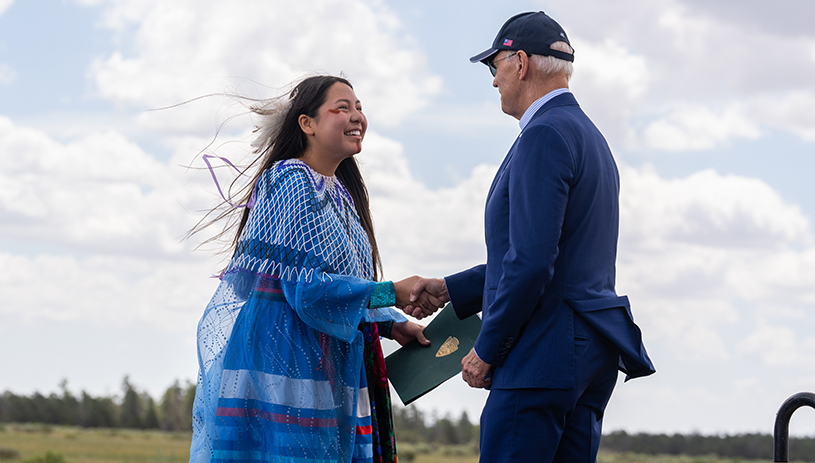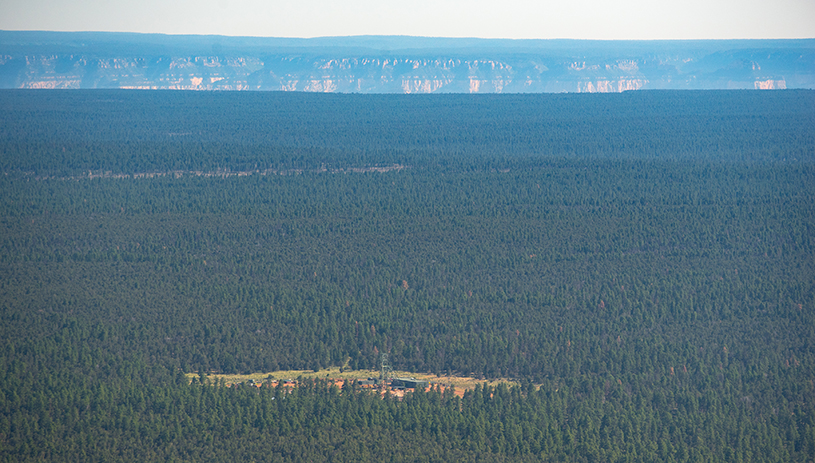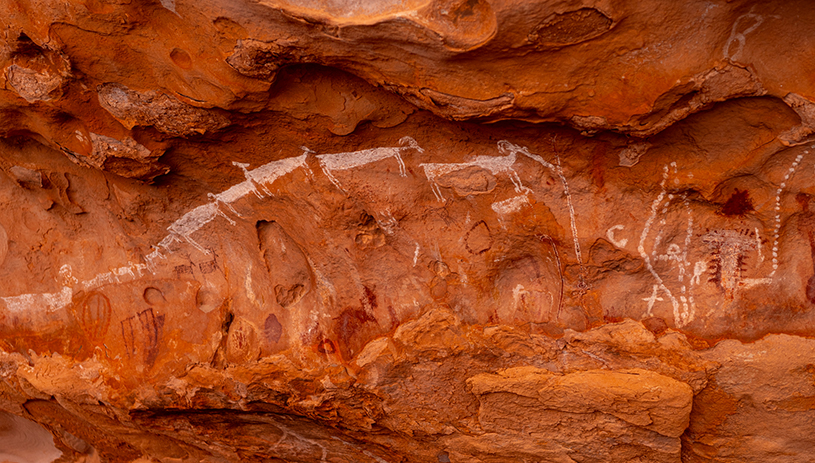
BY AMBER REIMONDO
On August 8, 2023, wind gusts raised fine veils of dust and sunshine warmed the faces of the assembled crowd as Maya Tilousi-Lyttle — the teenage daughter of Havasupai advocate Carletta Tilousi — spoke powerfully from a podium bearing the U.S. presidential seal. It was a day many had waited decades for.
At the conclusion of Maya’s introduction, President Joe Biden walked onto the stage in the foreground of Red Butte and minutes later, surrounded by leaders from 13 regional tribes, he signed the proclamation declaring Baaj Nwaavjo I’tah Kukveni – Ancestral Footprints of the Grand Canyon National Monument.

But that day, inside the monument, just two miles through the forest from where the president of the United States stood, loomed a threat that the newly designated monument, and its permanent mining ban, couldn’t touch: Canyon Mine (renamed Pinyon Plain Mine). And today, that threat is rearing its ugly head.
In December 2023, the mine’s owner, Energy Fuels Resources, announced that for the first time in the mine’s history, uranium production had begun "in response to surging prices, supportive government policies, and a domestic focus on security of supply." Why didn’t the monument prevent this?
1986. That’s when Canyon Mine was first approved by the U.S. Forest Service despite opposition from the Havasupai Tribe. Since time immemorial, the Havasupai Tribe has used and held sacred the lands that the mine would come to desecrate. For decades the mine was only sporadically developed, idling for long stretches.
Up until December 2023, it had yet to commercially produce a single ounce of uranium ore. What it had done was crack open a Pandora’s box of potential water problems that will only open wider now that the mine is operating and exposing more mineralized rock to the elements.
 Canyon uranium mine with the Grand Canyon in the distance. BLAKE MCCORD, FLOWN BY ECOFLIGHT
Canyon uranium mine with the Grand Canyon in the distance. BLAKE MCCORD, FLOWN BY ECOFLIGHTAfter the mine’s initial approval in 1986, the operator dug a hole in the ground 50 feet deep and then stopped digging, blocking tribal or public access to the national forest land behind the mine fence. Then in 2011, after the Obama administration established a temporary administrative mining ban in the region, the mine’s owner informed the U.S. Forest Service of its intent to further develop the mine, arguing that the company had “valid existing rights” that were exempt from the ban. The Forest Service agreed.
The Havasupai Tribe, Grand Canyon Trust, Sierra Club, and Center for Biological Diversity sued to challenge the mine’s exemption. The Trust argued, among other claims, that a mining company cannot have valid existing rights unless its mining claim covers a mineral deposit that can be economically extracted, both at the time mining is banned and at any later point when the government examines the claim’s validity. In short, if you can profitably mine the mineral deposit you’ve claimed at the moment the mining ban takes effect and that remains true when the validity of your claim is evaluated, you can generally satisfy the valid-rights exemption. But uranium had a low market value around the time that mining was banned around the Grand Canyon, casting serious doubt on whether the uranium at Canyon Mine could be profitably mined.
Unfortunately, after years of back and forth, in 2022, the legal effort to prevent the mine’s exemption from mining bans proved unsuccessful. A federal court decided that under the antiquated 1872 General Mining Law, the Forest Service had not made an error when it concluded that the mine could be operated at a profit, despite the agency’s disregard of expenses that went into developing the mine prior to 2012.
During the years the legal challenge was moving through the courts, the mining company continued sporadically to develop the mine. But the company took its time, 11 years to be exact, waiting for prices to climb. In that time, miners finished digging the 1,470-foot-deep mine shaft, which pierced an aquifer in late 2016, causing a still-ongoing influx of water into the mine that must be managed 24-7 to prevent uranium and arsenic-laced water from leaching out of the mine shaft and into connected groundwater sources.
Since 2016, the mine has pumped millions of gallons of water out of its mine shaft — as of 2023, the total was over 66 million gallons — both wasting limited water resources in an arid region and demonstrating the long-term challenge of protecting groundwater far into the future, especially after the mining company has moved on.
Why now? The company’s stated reason for starting up the mine in December 2023 was "surging prices, supportive government policies, and a domestic focus on security of supply." But let’s dig into that.
Prices are surging — they were up over $100 per pound in January 2024, the highest they’ve been in over 15 years. Driving prices, in part, is the fact that the Biden administration has touted nuclear energy as a major policy priority. Russia’s invasion of Ukraine has stepped up the desire to move away from any amount of U.S. uranium supply coming from Russia.
But how does Canyon Mine contribute to these priorities in any significant way? The short answer: it doesn’t.
 Rock writings in the western parcel of Baaj Nwaavjo I’tah Kukveni – Ancestral Footprints of the Grand Canyon National Monument. BLAKE MCCORD
Rock writings in the western parcel of Baaj Nwaavjo I’tah Kukveni – Ancestral Footprints of the Grand Canyon National Monument. BLAKE MCCORDCanyon Mine offers nothing but heartache. According to the mine’s 2023 technical report, the company expects the mine to operate for 28 months — that’s right, fewer than two and a half years. Over those 28 months, it expects to produce 1.57 million pounds of uranium — that’s once it’s milled from raw ore at the company’s White Mesa Mill near Bears Ears National Monument, of course, and the company says it won’t start that process until at least 2025 subject to several conditions. For context, U.S. nuclear power plants purchase 40-50 million pounds of uranium every year. 1.57 million pounds is only a tiny fraction of annual U.S. uranium demand.
While the market environment and the company’s own production estimates don’t reflect an actual need for Canyon Mine’s uranium, what we can see clearly is that we’re in an attractive marketing window for a company to finally cash out on a bad investment and appear to be serving national-security interests in the process. It’s tribal communities, sacred lands, and irreplaceable and delicate water resources in a region critical to climate resilience in the Southwest that will pay the price.
What now? There’s no simple answer, but there are a few things that we can focus on. First, we can do everything in our power to ensure that the mine operator complies with regulatory standards, including the mine’s closure plan, once it finishes mining. We can also press government leaders to keep a close eye on this high-risk mine. And more broadly, we can continue our advocacy for reforming the outdated 1872 General Mining Law, which treats mines like this one as the highest and best use of the land and leaves little to no room for tribes or the public to say, "not here."
 Amber Reimondo directs the Grand Canyon Trust’s Energy Program.
Amber Reimondo directs the Grand Canyon Trust’s Energy Program.
EDITOR'S NOTE: The views expressed by Advocate contributors are solely their own and do not necessarily represent the views of the Grand Canyon Trust.